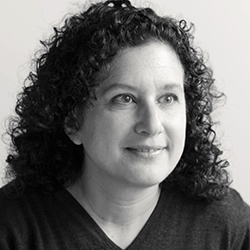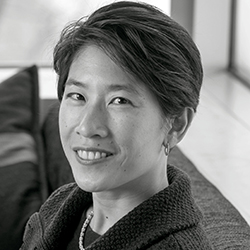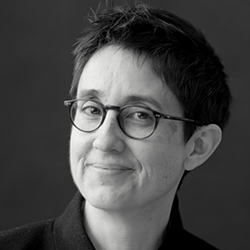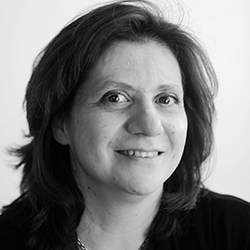
Staying in STEM
Encouraging Women to Persist in Math and Science.
Studies show that girls are no less capable than boys when it comes to science, technology, engineering, and math. But women who advance in these fields eventually find they are vastly outnumbered. What will it take to close the gap?
When Bryna Kra, the future chair of Northwestern’s Department of Mathematics, told her freshman adviser in college that she was interested in advanced math, the adviser told her that women major in English and history.
When Catherine Woolley, now a Northwestern neurobiologist, was applying to graduate school, she was told to consider “lower-level” institutions rather than Rockefeller University, where she went on to earn her PhD — despite the fact that she’d won the prize for best undergraduate honors thesis at her university.

Professor Bryna Kra
Other women scientists at Northwestern who earned doctorates at Harvard, Stanford and MIT have similar stories about being advised to consider “easier” programs. Fortunately, they also received good advice to counteract the bad, though it rarely came from women: Kra never had a female math professor. Northwestern astrophysics professor Vicky Kalogera never had a female physics professor. There were no female professors when Woolley arrived at her graduate school.
A deficit of mentors and female role models, along with subconscious biases against women, have discouraged women from pursuing careers in science and math, many female professors say. The issues can be tackled with a range of programs and ideas (see sidebars). But change will take education and time.
The issue drew headlines in October, when The New York Times published an article asking “Why Are There Still So Few Women in Science?” Many were struck in particular by a 2012 Yale University study that suggested that female scientists are still viewed as “less competent and less worthy of being hired” than their male counterparts.
In the study, researchers submitted identical resumes on behalf of young female and male scientists ostensibly seeking lab management positions. Though their qualifications were the same, the women applicants were consistently offered lower starting salaries and less career mentoring than the men — regardless of whether those reviewing the resumes were male or female.
“I’m reluctant to make generalizations about men versus women because I’m a scientist and I want to base my beliefs on evidence — and my own personal experience isn’t really evidence, it’s anecdotal,” Woolley says. “That’s why the Yale study was so satisfying. It was unbiased evidence, and it validated what many of us have been feeling.”
Looking for Role Models

Professor Teri Odom
It’s hard to pinpoint where and how the bias against women in math and science begins. But “we have to get over the idea that one is born destined to be good at science or bad at science,” says Woolley. Studies have shown that women are no less capable than men in STEM fields.
Those findings are borne out by a long-running Duke University study that has tracked the performance of boys relative to girls in the math portion of the SAT. Thirty years ago, the ratio of boys to girls who exceeded the score of 700 was 13:1. That ratio has since dropped dramatically to 4:1.
In addition, girls have performed at least as well as boys in math in 27 of the 65 nations that administer the PISA (Programme for International Student Assessment), an exam given to 15-year-olds around the world, and have outperformed boys in five of those nations. In science, boys and girls perform similarly. Those results suggest that female success in science and math is culturally dependent rather than hardwired.
Yet many girls who are interested in STEM leave the field before their early promise is realized. “Girls are already getting the message in kindergarten, first and second grade that boys are better at math. It’s not said explicitly, but by the time they reach high school, they start dropping off,” observes Kra, who ran a “fun math” program in the Evanston public schools with a few graduate students for several years so that second graders could see women mathematicians in action. “Part of the problem is they don’t have role models.”
Chemistry Professor Teri Odom says that from high school on, she simply got used to being one of the few women in class. Kra was one of just three women out of 25 undergraduates in her elite freshman math class, and observed that being in the minority can be difficult. “If you’re looking for people who look like you, you don’t see them much in math,” says Kra, who wrote the Times article’s author to thank her for the story. “And that can be a subtle form of discouragement.”
Most women who have made it to the highest academic levels can point to people who’ve helped them feel they belong in the field, says Kra, whose father is a university mathematics professor. “Unfortunately, that’s not true for everybody, and I think maybe women need that (encouragement) a bit more than men, because there are so few women. I think if women were the majority, they wouldn’t need that extra encouragement.”
Beyond the Comfort Zone

Professor Catherine Woolley
Among top research institutions, Northwestern’s male-female ratio of faculty in the math and sciences is typical. Among 22 full professors in the Department of Physics and Astronomy, three are women. Kra is the only woman among 18 full professors in Mathematics. Odom is one of two women among 22 full professors whose primary appointment is in Chemistry.
The scarcity of female professors isn’t for lack of trying, explains Odom. One factor contributing to the disparity is what’s commonly known as the “two-body problem,” and reflects the high tendency of female academics to partner with other academics. Universities often find that a faculty candidate won’t accept a job offer unless an offer is made to his or her partner as well. That may not be feasible when both candidates are in a similar field — as is often the case with women in STEM disciplines.
“If you want a woman scientist, 90 percent of the time she has a partner who’s also a scientist. To be hired at an institution such as Northwestern, they both need to be excellent and leaders in their fields,” says Odom, whose husband is an assistant professor of physics and astronomy at the University. Larger institutions can help by creating more opportunities for couples in STEM fields, she adds.
But even before they reach that level, the ranks of female mathematicians and scientists are thinned by attrition at the post-doctoral level, when couples frequently move. Often, “the woman will either not apply for a post-doc position or she’ll wait until her husband applies and then apply where he goes, which narrows her options,” says Kalogera, co-founder and director of Northwestern’s Center for Interdisciplinary Exploration and Research in Astrophysics (CIERA).“Culturally, it (can be) more comfortable for a woman to say, ‘I’ll stay at home and start a family or be with the kids for a few years while my partner works.’ It’s much less likely for the guy to say this.”
Some women might get discouraged early by the combative nature of defending one’s work. “There’s a lot of criticism involved in science,” says Woolley. “You present your work and part of what I do is find what’s good in it as well as the flaws. Your job is to defend against my criticism. Speaking very generally, I find that girls and women are less likely to enjoy that combativeness. Among the students in my class, I’ve seen boys tending to view competition and confrontation more often as an opportunity to win, and girls tending to view it more often as a chance to lose.”
In addition, says Woolley, women are often at a -disadvantage when it comes to social cues used to ascertain dominance and authority. “We’re smaller and our voices aren’t as deep. And often girls are socialized to be pleasant, to defer and be likeable, so we (tend to) fall back on likability if we’re not able to assert authority. In some ways that works, and in many ways it doesn’t. In a career that’s based upon persuading people that what you’re doing is good and in fact better than what most people in your field are doing, those kinds of cues are really important.”

Professor Vicky Kalogera
Kalogera recalls elbowing her way into discussions during coffee breaks at conferences when she was a graduate student. “I’m short, especially compared to Americans and guys,” says the Greek-born Kalogera. “I realized then that there’s a long history of discrimination that up until rather recently was accepted and considered normal. It’s hard to get rid of that over one or two generations.”
Such discrimination, Kalogera believes, isn’t based on malice but is often unconscious. Indeed, the Yale researchers found that the bias they uncovered among faculty was “independent of their gender, scientific discipline, age, and tenure status,” suggesting that it is “unintentional (and) generated from widespread cultural stereotypes rather than a conscious intention to harm women.”
But the rewards of overcoming such hurdles are significant. Constant intellectual challenge, opportunities to work globally and the chance to pursue discoveries that can affect millions of lives are just a few of the benefits of STEM careers. In addition, women in STEM fields earn an average of 33 percent more than their non-STEM counterparts.
That’s good news for women at Weinberg College, who are studying STEM in increasing numbers. In fact, the College has seen an 83 percent rise in the number of undergraduate degrees awarded to women in physics, biological science, math and statistics since 2004.
And women are needed in these fields. Two years ago, the President’s Council of Advisors on Science and Technology called for an additional 1 million STEM professionals to meet the demands for science and technology innovation. Clearly, women with gifts in math and science represent a huge swath of untapped talent.
“It’s not that a male colleague sits at his desk and thinks, ‘I hate having a female colleague here,’” Kalogera says. “I don’t think anyone thinks this way. But we can’t change the effects of this (gender disparity in STEM) without making people aware of the magnitude of the problem.”
Back to top